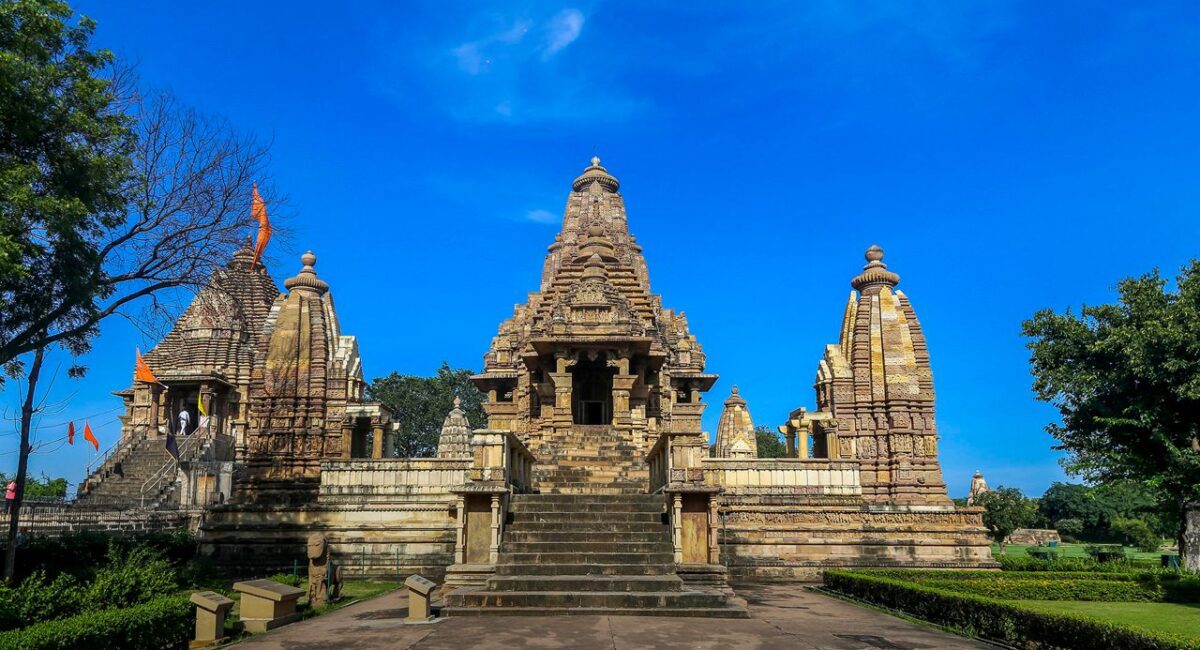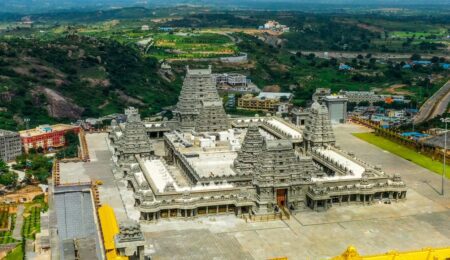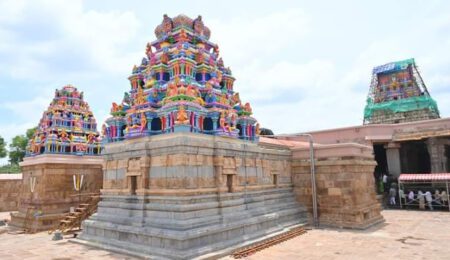Lakshmana Temple: A Timeless Masterpiece of Chandela Dynasty Architecture
Introduction: Where Divinity Meets Design
In the heart of Madhya Pradesh, amidst the quiet elegance of Khajuraho, stands the Lakshmana Temple an architectural marvel that transcends time. As part of the celebrated Khajuraho Group of Monuments, this temple is a beacon of ancient Indian architecture, spiritual devotion, and artistic excellence. Built in the 10th century CE, it is one of the oldest and most intricately designed temples in the region, showcasing the grandeur of Chandela dynasty architecture and the refined aesthetics of the Nagara style.
Recognized as a UNESCO World Heritage Site, the Lakshmana Temple is not merely a place of worship but a cultural landmark that continues to inspire historians, architects, and pilgrims alike. Its elaborate carvings, mythological depictions, and symbolic erotic sculptures make it a cornerstone of Temples of Madhya Pradesh tourism and a must-visit destination for anyone seeking to understand the spiritual and artistic legacy of India.
Historical Context: The Rise of a Sacred Marvel
Origins and Patronage
The Lakshmana Temple was commissioned by King Yashovarman of the Chandela dynasty, who ruled during the early 10th century CE. Yashovarman was a visionary ruler who sought to establish Khajuraho as a spiritual and cultural center. The temple was built to enshrine an image of Vaikuntha Vishnu—a composite deity representing Vishnu’s avatars: Varaha (boar), Narasimha (lion), and a human form. This tri-headed idol symbolized divine protection, cosmic balance, and the multifaceted nature of Vishnu.
The temple’s construction marked a significant moment in the history of central India, as it reflected the Chandela dynasty’s growing political power and cultural sophistication. It was not merely a religious edifice but a statement of dynastic pride and spiritual commitment.
Historical Influences
The 10th century CE was a period of dynamic change in Indian history. The Chandelas, originally feudatories of the Pratihara empire, began to assert their independence and invest in monumental architecture. Influenced by Tantric traditions, Vaishnavism, and regional artistic schools, the Lakshmana Temple became a synthesis of spiritual ideologies and architectural innovation.
This era also witnessed the flourishing of temple-building activities across India, with regional styles evolving in response to local materials, religious practices, and artistic preferences. The Lakshmana Temple stands as a quintessential example of this evolution, embodying the ideals of ancient Indian architecture while reflecting the unique cultural milieu of the Chandela period.
Architectural Grandeur: Nagara Style in Full Bloom
Structural Layout
The Lakshmana Temple is a textbook example of Nagara style architecture, which is characterized by its curvilinear shikhara (spire), elevated platform (jagati), and axial alignment. The temple follows the Panchayatana plan, with a central shrine surrounded by four subsidiary shrines at the corners of the platform. This layout symbolizes the cosmic order and the centrality of divinity in the universe.
The temple comprises several key architectural components:
- Ardhamandapa (entrance porch)
- Mandapa (pillared hall)
- Maha-Mandapa (main assembly hall)
- Antarala (vestibule)
- Garbhagriha (sanctum)
The shikhara is clustered with miniature spires (urushringas), creating a mountain-like silhouette that symbolizes Mount Meru—the mythical axis of the universe in Hindu cosmology. The temple’s verticality and symmetry evoke a sense of spiritual ascent, guiding the devotee’s gaze and consciousness toward the divine.
Proportions and Precision
Built entirely of sandstone, the temple rests on a high platform that enhances its visual dominance and ceremonial significance. The sanctum is pancharatha in plan, meaning it has five projections on each side. The walls are adorned with balconied windows, ornate balustrades, and sculptural panels that narrate divine tales and scenes from daily life.
The architectural precision of the Lakshmana Temple is evident in its harmonious proportions, intricate detailing, and spatial coherence. Every element—from the base moldings to the crowning amalaka—has been meticulously crafted to create a unified aesthetic experience.
Sculptural Highlights: Divine Drama in Stone
Vishnu and His Avatars
At the heart of the temple lies the Vaikuntha Vishnu idol a four-armed, tri-headed sculpture representing Vishnu’s multifaceted nature. The sanctum doorway features seven vertical panels (sakhas), with the central one depicting the Dashavatara—the ten incarnations of Vishnu. These include Matsya (fish), Kurma (tortoise), Varaha (boar), Narasimha (lion), Vamana (dwarf), Parashurama, Rama, Krishna, Buddha, and Kalki.
The lintel above the doorway showcases Goddess Lakshmi flanked by Brahma and Vishnu, reinforcing the temple’s Vaishnavite identity and the divine triad of creation, preservation, and prosperity.
Celestial Beings and Mythological Scenes
The outer walls of the temple are a visual feast of celestial beings, mythological narratives, and scenes from everyday life. These include:
- Apsaras and Yakshis in graceful postures
- Musicians, dancers, and court scenes
- Hunting expeditions, elephant duels, and military processions
These carvings reflect the social vibrancy and artistic sophistication of the Chandela period. They also serve as visual metaphors for spiritual ideals, moral values, and cosmic principles.
Erotic Sculptures of Khajuraho
One of the most talked-about aspects of the Lakshmana Temple is its sensual art. Depictions of mithuna (loving couples), some engaged in intimate acts, are carved with elegance and symbolism. Far from being mere titillation, these images represent:
- Tantric ideals of union and liberation
- Fertility and prosperity
- Spiritual transcendence through physical experience
Such art was deeply rooted in Kapalika and Tantric practices, which embraced the body as a vessel for divine realization. The erotic sculptures are integrated into the temple’s overall iconography, suggesting that spiritual enlightenment encompasses all aspects of human experience.
Religious and Cultural Significance
A Vishnu Temple in Madhya Pradesh
Dedicated to Vaikuntha Vishnu, the Lakshmana Temple played a vital role in Vaishnavism. It served as a center for ritual worship, festivals, and pilgrimage, reinforcing the spiritual fabric of Khajuraho and the surrounding region.
The temple’s iconography, rituals, and architectural symbolism reflect the theological principles of Vaishnavism, including the concepts of dharma (righteousness), bhakti (devotion), and moksha (liberation).
Rituals and Festivals
While specific ancient rituals are lost to time, the temple likely hosted:
- Vaikuntha Ekadashi celebrations
- Dashavatara-themed recitations
- Seasonal festivals aligned with solar and lunar calendars
Today, its legacy continues through the Khajuraho Dance Festival, where classical dancers perform against the backdrop of these sacred stones, reviving the temple’s cultural vibrancy.
Artistic Detailing & Symbolism
Carvings as Cosmic Narratives
Every sculpture in the Lakshmana Temple serves a symbolic purpose. For example:
- Women removing thorns symbolize grace and resilience
- Couples in embrace reflect divine union and moksha
- Deities in dynamic poses convey cosmic energy
The temple’s iconography aligns with Shilpa Shastra guidelines, which prescribe ideal proportions, gestures, and themes for temple art. The carvings are not merely decorative but serve as visual sermons that educate, inspire, and elevate the devotee.
Mythological Themes
Scenes from Ramayana, Mahabharata, and Puranas are subtly embedded in the reliefs. These include:
- Krishna lifting Govardhan
- Varaha rescuing Bhudevi
- Narasimha slaying Hiranyakashipu
Such narratives reinforce the temple’s role as a spiritual textbook carved in stone, offering moral guidance and theological insight.
Preservation & UNESCO Recognition
Role of ASI
The Archaeological Survey of India (ASI) has played a crucial role in preserving the Lakshmana Temple. Restoration efforts include:
- Structural stabilization
- Cleaning and conservation of sculptures
- Protection against environmental damage
The ASI also conducts research, documentation, and public outreach to promote awareness and appreciation of the temple’s heritage.
UNESCO World Heritage Site
In 1986, the Lakshmana Temple was inscribed as part of the Khajuraho Group of Monuments on the UNESCO World Heritage List, recognizing its:
- Architectural excellence
- Cultural significance
- Artistic legacy
This recognition has helped attract global attention, funding, and scholarly interest, ensuring the temple’s continued preservation and relevance.
Tourism Guide: Planning Your Visit
Best Time to Visit
- October to March: Pleasant weather
- February: Attend the Khajuraho Dance Festival
Entry Timings & Tickets
- Timings: 6:00 AM to 6:00 PM daily
- Entry Fee: ₹40 for Indian citizens, ₹600 for foreign nationals
- Children below 15 years: Free entry
- Photography: Permitted without flash; tripods may require special permission from ASI
Accessibility and Facilities
The temple complex is well-maintained and accessible via paved walkways. Wheelchair access is limited due to the elevated platform and steps. Basic amenities such as restrooms, drinking water, and shaded seating areas are available nearby. Local guides fluent in multiple languages can be hired at the entrance for a more immersive experience.
Nearby Attractions
Khajuraho is home to over 20 surviving temples, each with its own unique charm. When visiting Lakshmana Temple, consider exploring:
- Kandariya Mahadeva Temple: The largest and most ornate temple in Khajuraho, dedicated to Shiva.
- Chitragupta Temple: Dedicated to Surya, the sun god, with stunning depictions of royal processions.
- Parsvanatha Jain Temple: A fine example of Jain architecture with exquisite detailing.
- Khajuraho Archaeological Museum: Houses sculptures and artifacts recovered from the region.
Cultural Events
The Khajuraho Dance Festival, held every February, is a week-long celebration of classical Indian dance forms such as Bharatanatyam, Kathak, Odissi, and Kuchipudi. Performances take place in the open-air auditorium with the temples illuminated in the background, creating a surreal ambiance that blends art and spirituality.
How to Reach Lakshmana Temple, Khajuraho
Reaching the Lakshmana Temple, located in the Western Group of Monuments in Khajuraho, Madhya Pradesh, is convenient thanks to well-connected air, rail, and road networks. Whether you’re a domestic traveler or visiting from abroad, Khajuraho offers multiple access points to explore this UNESCO World Heritage Site.
By Air
Khajuraho Airport (HJR) is the nearest airport, located approximately 5.3 km from Lakshmana Temple. It is a domestic airport with regular flights from major Indian cities such as:
- Delhi
- Varanasi
- Mumbai
From the airport, you can hire a taxi or auto-rickshaw to reach the temple complex in under 15 minutes. The roads are well-paved, and the route offers scenic views of the town’s heritage landscape.
By Rail
Khajuraho Railway Station, situated about 8.3 km from the temple, connects the town to key cities like:
- Jhansi
- Satna
- Delhi
- Agra
Trains such as the Khajuraho Udaipur Express and Bundelkhand Express serve this route. Upon arrival, local transport options like taxis, cycle rickshaws, and shared autos are readily available to take you to the temple.
By Road
Khajuraho is accessible via a network of state highways and national roads. You can reach the temple by:
- Private car or taxi from nearby cities like Satna (120 km), Jhansi (175 km), or Bhopal (375 km)
- State-run buses from towns such as Chhatarpur, Panna, and Mahoba
The Khajuraho Bus Stand is just 900 meters from Lakshmana Temple, making it a short walk or quick auto ride to the site
Fascinating Facts & Lesser-Known Insights
Hidden Details in the Architecture
- The temple’s garbhagriha (sanctum) is windowless, creating a dark, meditative space that enhances the spiritual experience.
- A unique panel on the outer wall depicts the sculptor and his apprentices at work—an homage to the artisans who built the temple.
- The balustrades and pilasters are not merely structural but serve as canvases for miniature carvings, including flora, fauna, and geometric motifs.
Rediscovery During the British Period
In the early 19th century, British surveyors and explorers, notably T.S. Burt, stumbled upon the temples of Khajuraho, which had been largely forgotten and overgrown with vegetation. Their rediscovery led to renewed interest in Indian temple architecture and prompted documentation efforts by scholars such as Alexander Cunningham, the founder of the Archaeological Survey of India.
These early records played a crucial role in preserving the temples and bringing them to the attention of the global academic community. The Lakshmana Temple, in particular, was noted for its architectural purity and sculptural richness.
Symbolism of Erotic Imagery
The erotic sculptures, often misunderstood, are deeply symbolic. They are placed on the outer walls, suggesting that one must transcend worldly desires before entering the sanctum of spiritual purity. This placement aligns with Tantric philosophy, which views sexual union as a metaphor for cosmic creation and spiritual awakening.
Moreover, these depictions reflect the inclusive worldview of ancient Indian society, where art embraced all aspects of life joy, love, struggle, and transcendence.
Why Lakshmana Temple is a Must-Visit
The Lakshmana Temple is more than a historical monument—it is a living testament to India’s spiritual and artistic legacy. Its appeal lies in its ability to engage visitors on multiple levels:
- Architectural Excellence: A masterclass in Nagara style design, with perfect proportions and intricate detailing.
- Spiritual Depth: A sacred space dedicated to Vishnu, offering insights into Vaishnavite theology and ritual practice.
- Artistic Brilliance: Sculptures that narrate divine stories, celebrate human emotion, and explore philosophical themes.
- Cultural Resonance: A symbol of Chandela dynasty’s patronage and the syncretic traditions of medieval India.
Whether you are a devotee seeking spiritual solace, a student of architecture exploring ancient design principles, or a traveler drawn to India’s rich heritage, the Lakshmana Temple offers an experience that is both profound and unforgettable.
FAQs Section
Who built Lakshmana Temple?
The Lakshmana Temple was built by King Yashovarman of the Chandela dynasty around 930–950 CE. It was one of the earliest temples constructed in Khajuraho and marked the beginning of the region’s architectural renaissance.
What makes Lakshmana Temple unique?
Its uniqueness lies in its Vaikuntha Vishnu idol, Panchayatana layout, and Nagara style architecture. The temple also features some of the finest examples of erotic sculptures of Khajuraho, which are symbolic and philosophical rather than purely sensual.
Are the sculptures of Lakshmana Temple similar to Kandariya Mahadeva Temple?
While both temples belong to the Khajuraho Group of Monuments and share stylistic elements, the Lakshmana Temple is more restrained and symmetrical in its sculptural program. The Kandariya Mahadeva Temple, built later, is larger and more ornate, with a greater emphasis on verticality and complexity.
Is Lakshmana Temple part of a UNESCO World Heritage Site?
Yes, the Lakshmana Temple is part of the Khajuraho Group of Monuments, which was designated a UNESCO World Heritage Site in 1986 for its outstanding architectural and cultural value.
What is the significance of the erotic sculptures?
The erotic sculptures represent Tantric ideals, fertility, and spiritual union. They are placed on the outer walls to signify the transition from the material to the spiritual realm, aligning with ancient Indian philosophical thought.
What is the best time to visit Lakshmana Temple?
The ideal time to visit is between October and March, when the weather is pleasant. February is especially recommended for those interested in attending the Khajuraho Dance Festival.
Conclusion: Preserving a Sacred Legacy
The Lakshmana Temple stands as a timeless embodiment of India’s spiritual depth, artistic brilliance, and architectural mastery. From its origins in the Chandela dynasty to its recognition as a UNESCO World Heritage Site, the temple continues to inspire awe and reverence.
Its carvings speak of gods and mortals, of love and liberation, of cosmic order and earthly beauty. It invites us not only to admire its form but to engage with its meaning—to see in stone the eternal dance of creation and consciousness.
As we celebrate and share this legacy, let us also commit to responsible heritage tourism. Respect the sanctity of the site, support conservation efforts, and educate others about the profound cultural narratives embedded in its walls.




Leave a Comment